Identifying Intent Using the Search Query
Some time ago I was asked by a customer to get their website to rank for the term “London Olympics.” This request was only a few weeks before the event took place and from a competitive standpoint, there was no way to get into those search results in that short period of time. But that wasn’t the issue. The real problem was that the client was selling Union Jack rugs. They seriously wanted their rug website to rank for the term “London Olympics” and didn’t consider, even for a second, that someone searching for “London Olympics” wasn’t looking to buy rugs.
This is an extreme example, of course, but it highlights a big problem. Companies get obsessed with getting their websites to rank well, for as many terms as possible, without thinking about the searcher. This mistake often leads to a mismatch between the searcher’s intent and the company’s website content, and that is bad news for everyone.
We need to change this mindset. We need to start with the searcher, think about what they are looking for, consider what they are looking to achieve, and then create our content around that.
We need to match our content to the searcher's intent.
Using Search Queries to Identify Meaning and Intent
So we start with the search query itself. Of course, more often than not the queries we start with are fragments, and leave a lot of room for interpretation. But you would be surprised how much we can learn from queries, even if they are only comprised of a couple of words. Let’s take a look at how we can use semantics and our understanding of natural language to identify the meaning and intent behind queries.
1. Taking apart the query to identify individual elements like verbs and nouns, their meaning, and relationship. Do they have synonyms that could have been used? What tense are they written in? Do they have a single or dual meaning?

How many meanings does this query have?
This query has the potential of a multitude of meanings, as both the verb “catch” and the noun “cricket” could be read in different ways.
a. Watch cricket on TV, where “catch” equals watch and “cricket” refers to the sport.
b. Catching a cricket ball.
c. Catching a cricket, where “cricket” refers to the insect.
2. Using pre and suffixes to get a more precise meaning. Affixes can change the relationship between words (suffixes like -ing), infer time (prefixes like post- or pre-) or give broader context (prefixes like re- or un-).
Example: this search - Looking for the pet of your dreams?
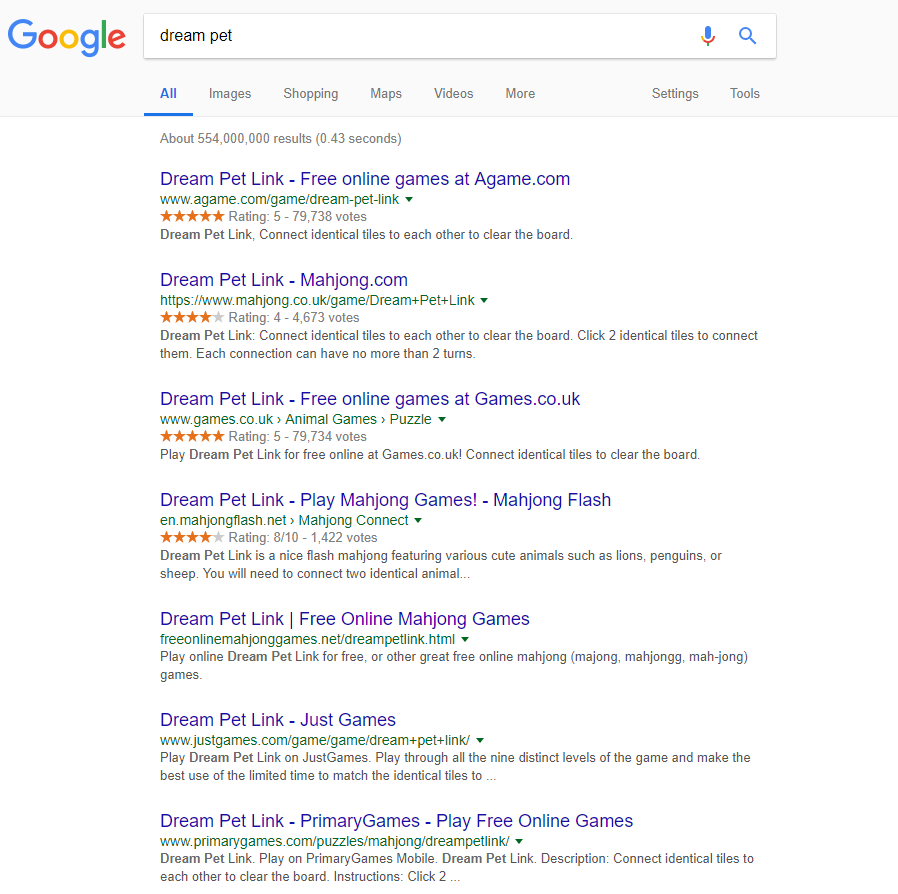
Vs. this search - Wondering what your pet is dreaming about?
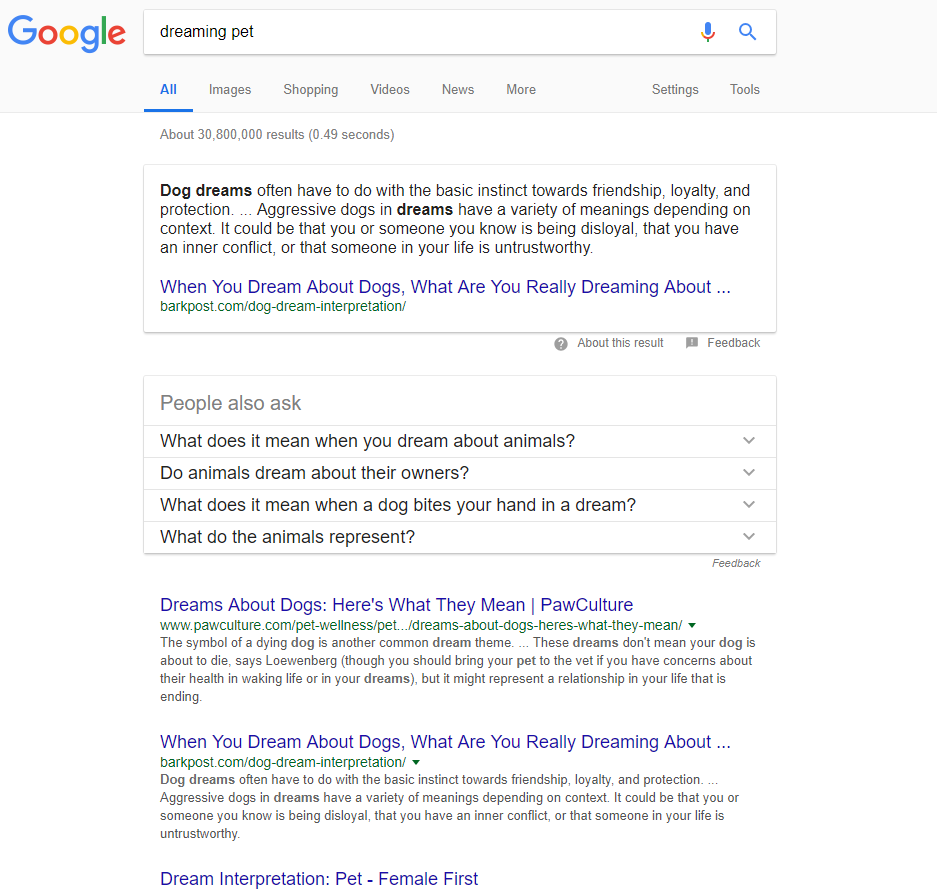
3. The syntax of the search, i.e., how it is phrased, can completely change the meaning of it, even for concise queries. The great news is that as search changes and becomes more conversational, especially driven by voice search, the queries we research are becoming longer, which gives us much more clarity. We also rely less on trained search behavior, where we adapt our natural language to adjust to early search engines. As search engines are becoming ever more intelligent, we return to using natural language when searching.
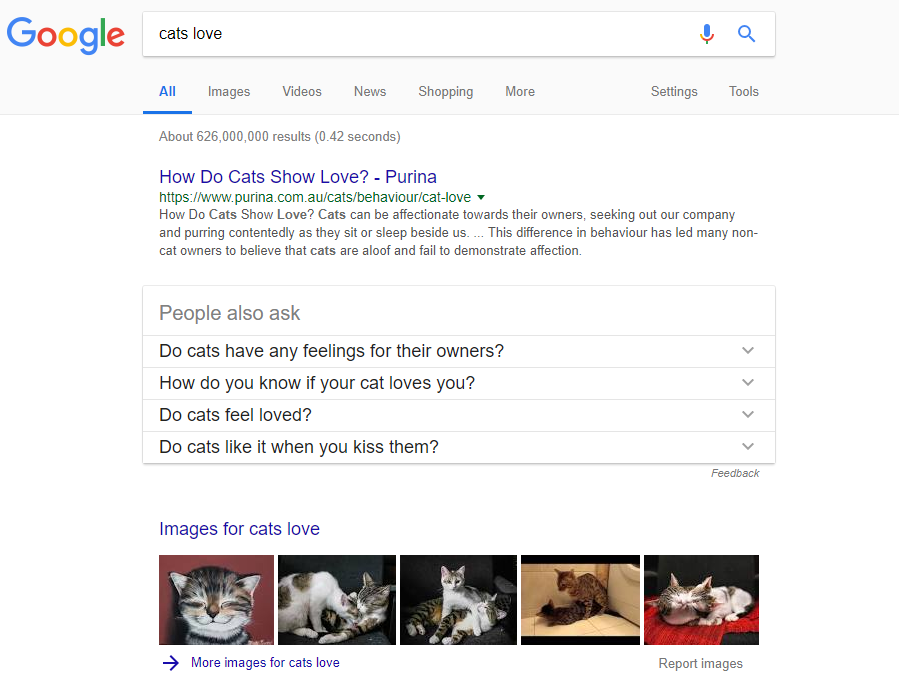
What do cats love?
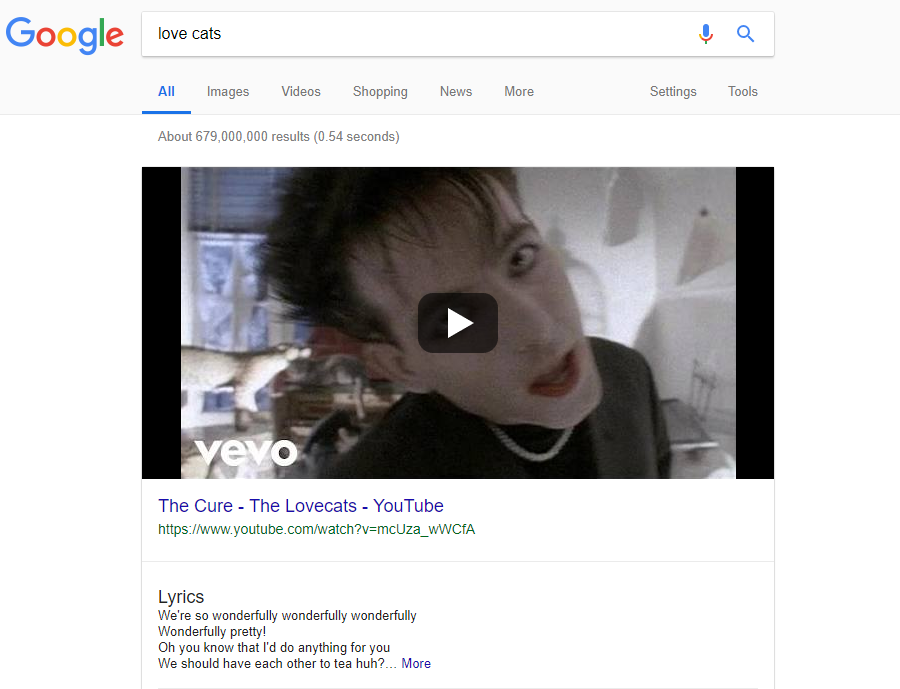
Looking for The Cure song.
Dissecting each query like this will give you a good idea of what the intent behind them might be. Often you will be able to make a list of various potential intents, but most likely you will need to narrow this list down using another method for identifying intent.
The next step in identifying possibilities is to use intent modifiers. Modifiers will allow you to easily establish what intent stage the searcher is in. You will be able to determine whether the searcher is in the informational, commercial, transactional or local stage of the user journey. You can classify them by intent type. Moreover, modifiers allow you to identify these stages at scale, so you can even use them for a giant keyword list.
What are intent modifiers?
Intent modifiers are just words that imply intent. For example, the word "best" implies that the searcher is looking to compare. So the broad, informational query “cat toilet” becomes immediately commercial if we add the modifier “best cat toilet.” Using another modifier will make “buy cat toilet” transactional, we know the searcher is now looking to buy. And if they are thinking about buying it in a store they might add “buy cat toilet near me”, so we know its a local, transactional query.
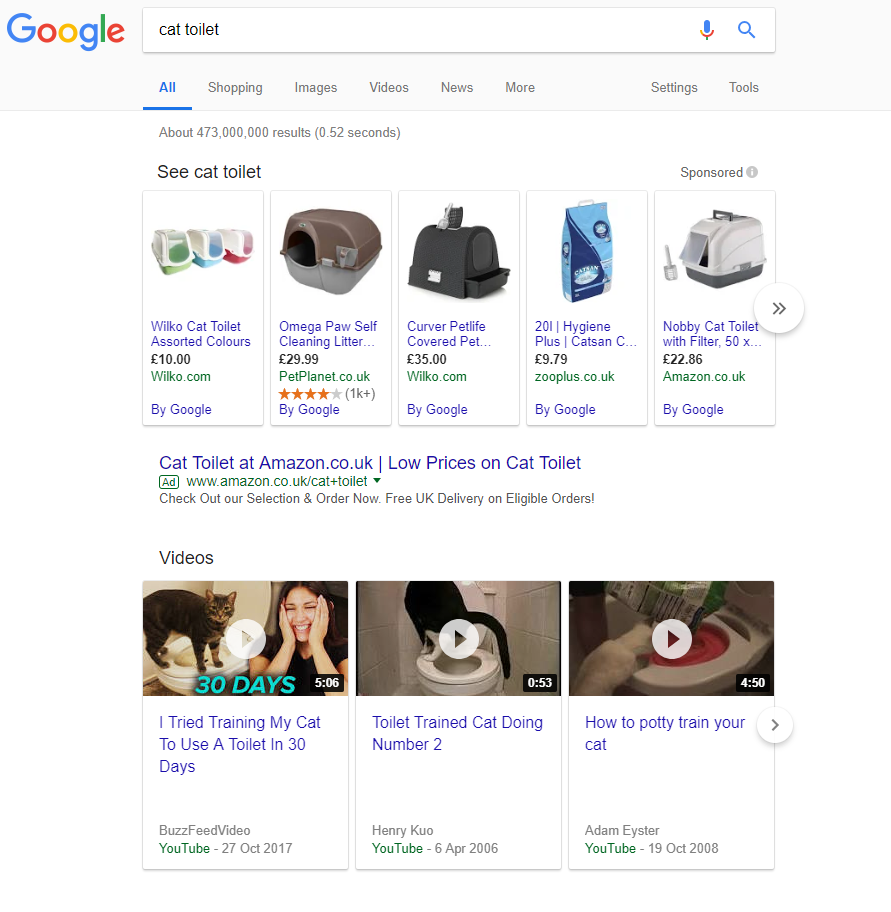
Informational query 'cat toilet'.
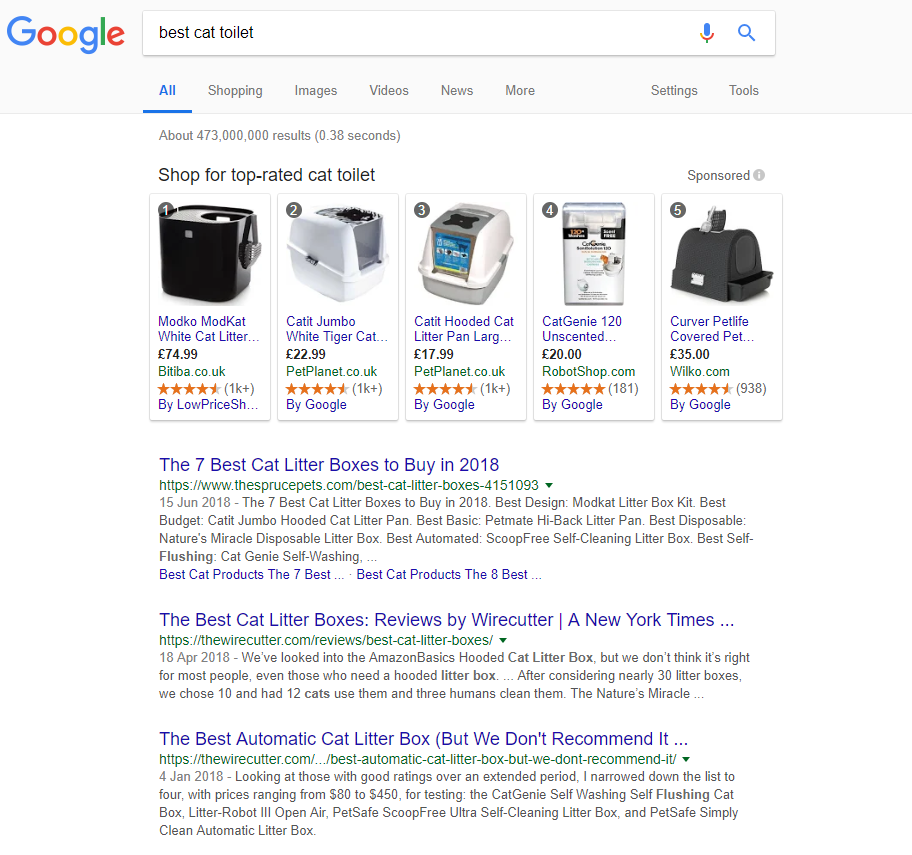
Commercial query 'best cat toilet'.
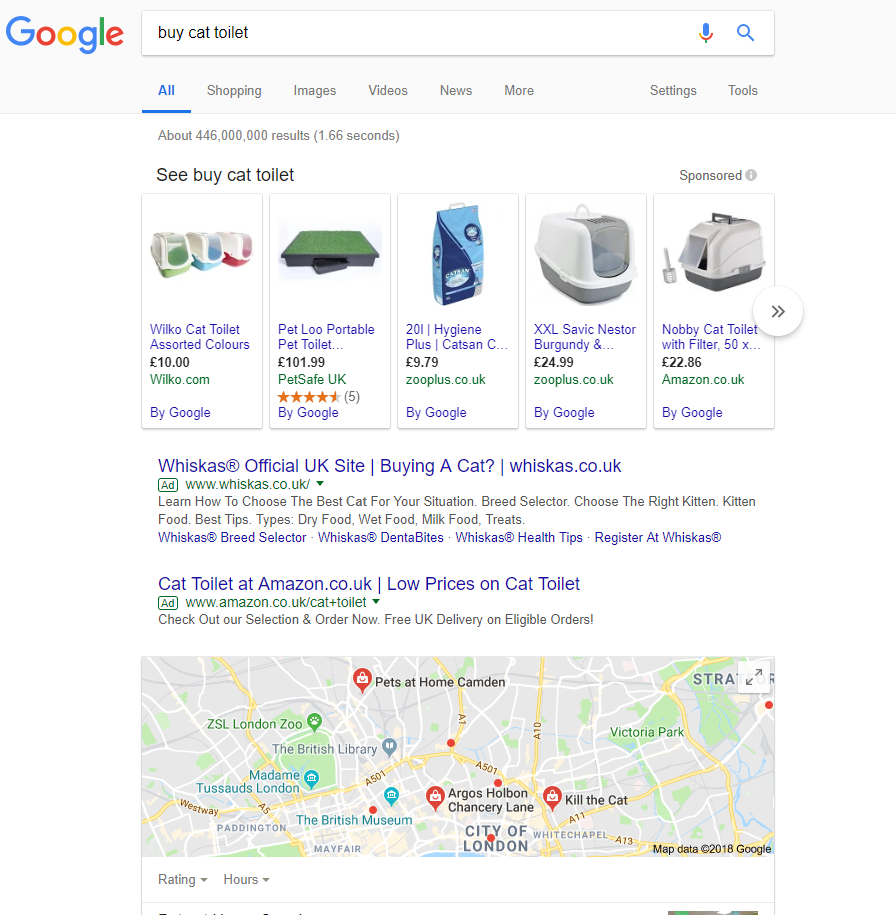
Transactional query 'buy cat toilet'.
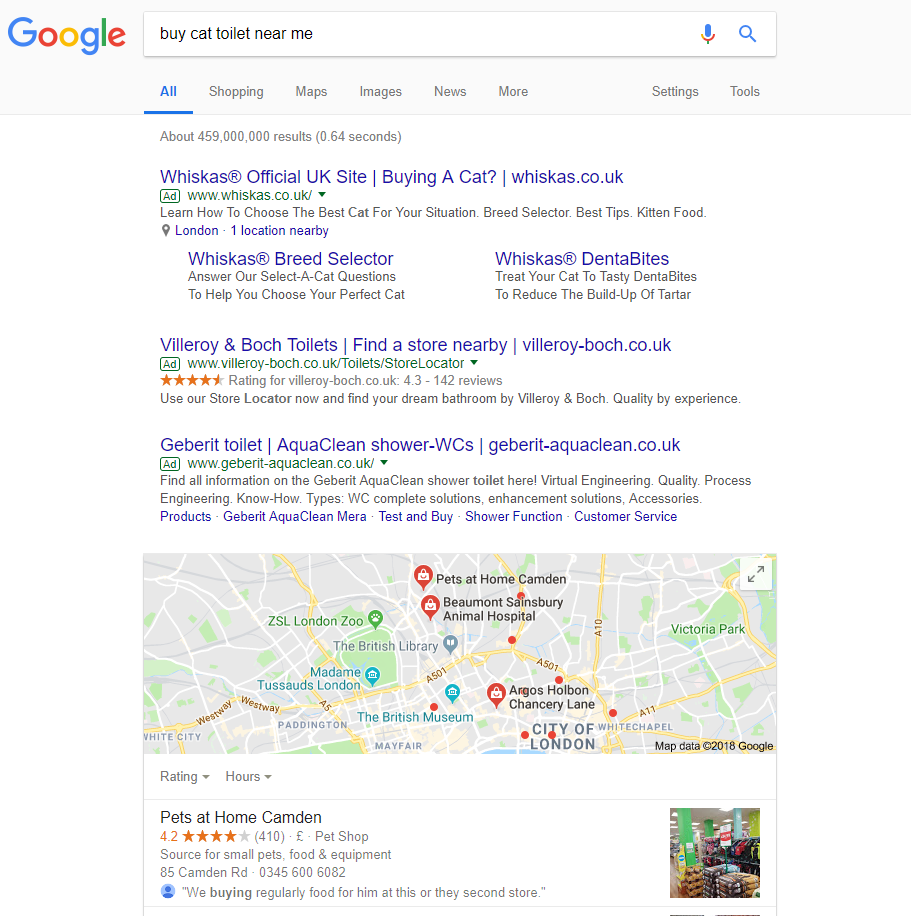
Local, transactional query 'buy cat toilet near me'.
You can either use a ready-made list of generic search modifiers, like the example above. Or you can read this guide from STAT and make your own list of intent modifiers. Stat has done some incredibly valuable research into optimizing for intent, so I do recommend you read their findings on their blog.
Segmenting Keyword List by Intent Type
Once you have a list of intent modifiers, you can segment your keyword list by intent type. Using your intent buckets, you can now amend your existing content or create new content matching the intent of the user. So any keyword in the transactional intent bucket should be mapped with a product page whereas commercial terms should result in category pages, or comparison articles (make sure you match the searcher’s objective, which will vary depending on the meaning of each query and modifier). You get the idea.
You can see that taking apart the search query and understanding the meaning behind each component allows you to understand the meaning and intent behind the query and sometimes even allows you to categorize it by intent stage.
Identifying Search Intent Using the SERP
Now, we will look at how to use search engine result pages to understand the searcher’s intent.
Google’s results don’t just tell us about different possible intents and intent stages behind a query; they also imply a certain amount of priority or majority intent. How? Search results are ranked based on which result is most relevant to the user and which will allow the searcher to meet her objective, that is, which results best match the searcher’s intent. So naturally, the results that rank highest and have the greatest potential to achieve the searcher’s objective, in Google’s eyes.
NOTE: Of course, we need to take the findings from the following research with a pinch of salt and use our common sense, because even Google gets it wrong sometimes.
Identify Search Intent with Organic Search Results
Time to Google your query. Now let’s start dissecting the results.
- What do the search snippets tell us about search intent?
Read each snippet and write down what the title and description tell us about which objective the ranking page is solving. Often, looking at the first 5 results will leave you with a list of potential intents and intent stages. -
How do the top-ranking pages further our findings?
What intent do the results solve? What objective can the searcher achieve when interacting with the content of the ranking pages? Which user stage is the content written for? Can the user buy something on the page or is it just a comparison or a ‘best of’ list? - Who ranks well, who doesn’t?
Now take note of the order in which pages are ranked. It is likely that the top-ranking results are representing the majority intent.
Now rinse and repeat this for your entire keyword list. And take note of how results change for similar, related queries. Even a change as little as using the plural of a word can completely change the results and imply a different intent behind the search query.

Singular intent: 'eating pig'.
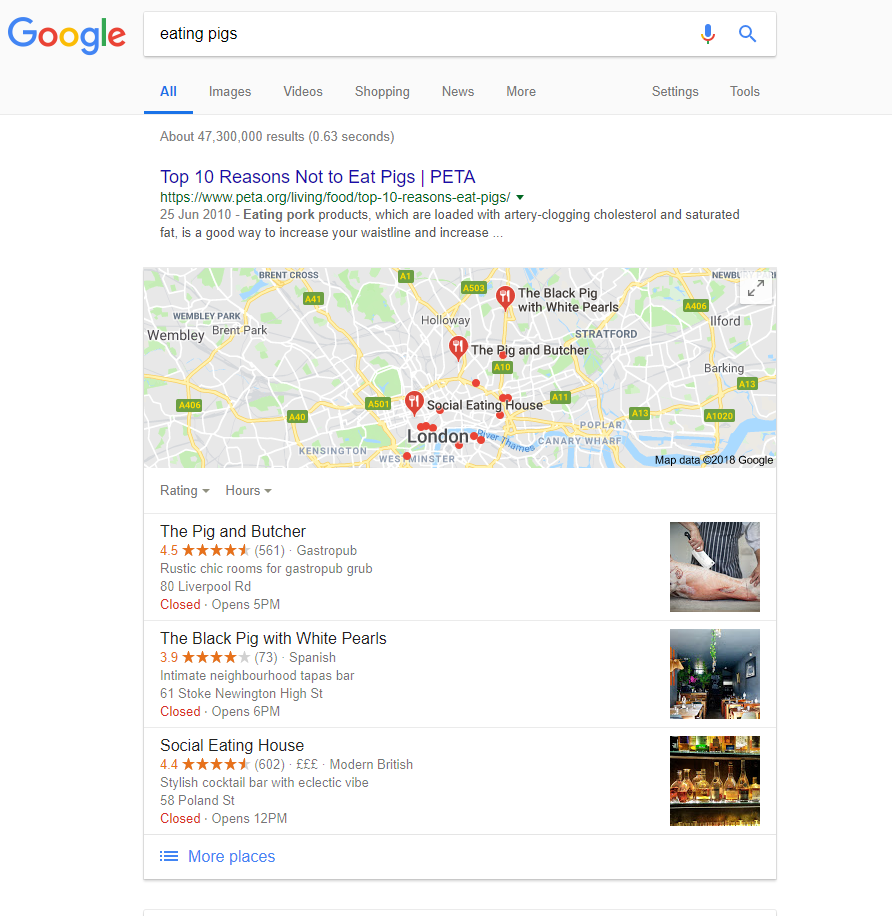
Plural intent: 'eating pigs'.
I often find that searches for professions or services result in job listings for singular searches, whereas the plural will result in businesses offering the service.

Singular intent: 'web developer' = Jobs.
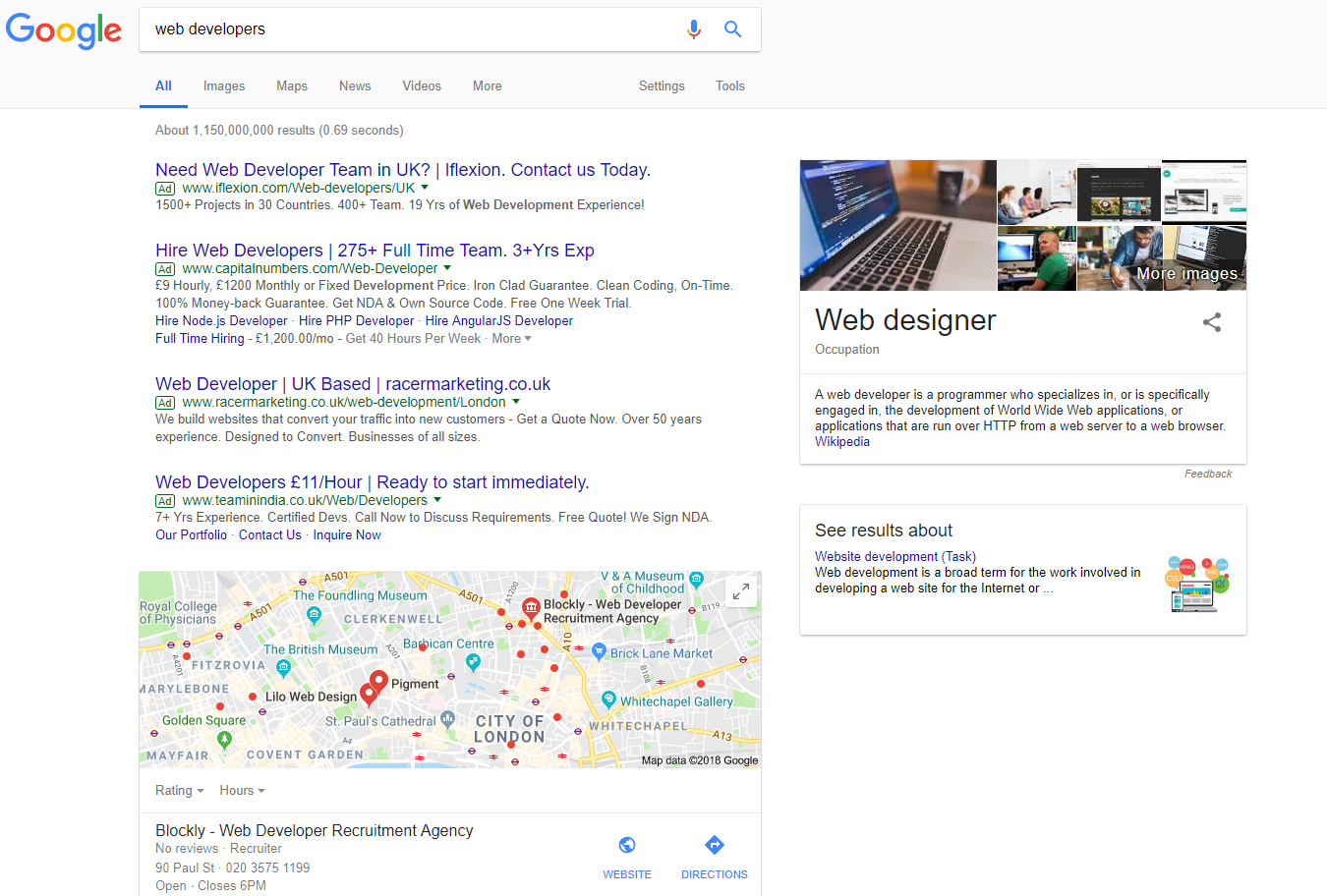
Make sure to be thorough. Don’t think you can skip a few of your queries, every detail counts!
Identify Intent with Search Features
Next, let’s take a look at what search features appear for your query. Just the fact that some search features appear for your query can imply the searcher’s intent stage.
So for example, shopping results instantly imply commercial intent. A local pack implies there is some local intent of the searcher.
Search Feature Intent Classification
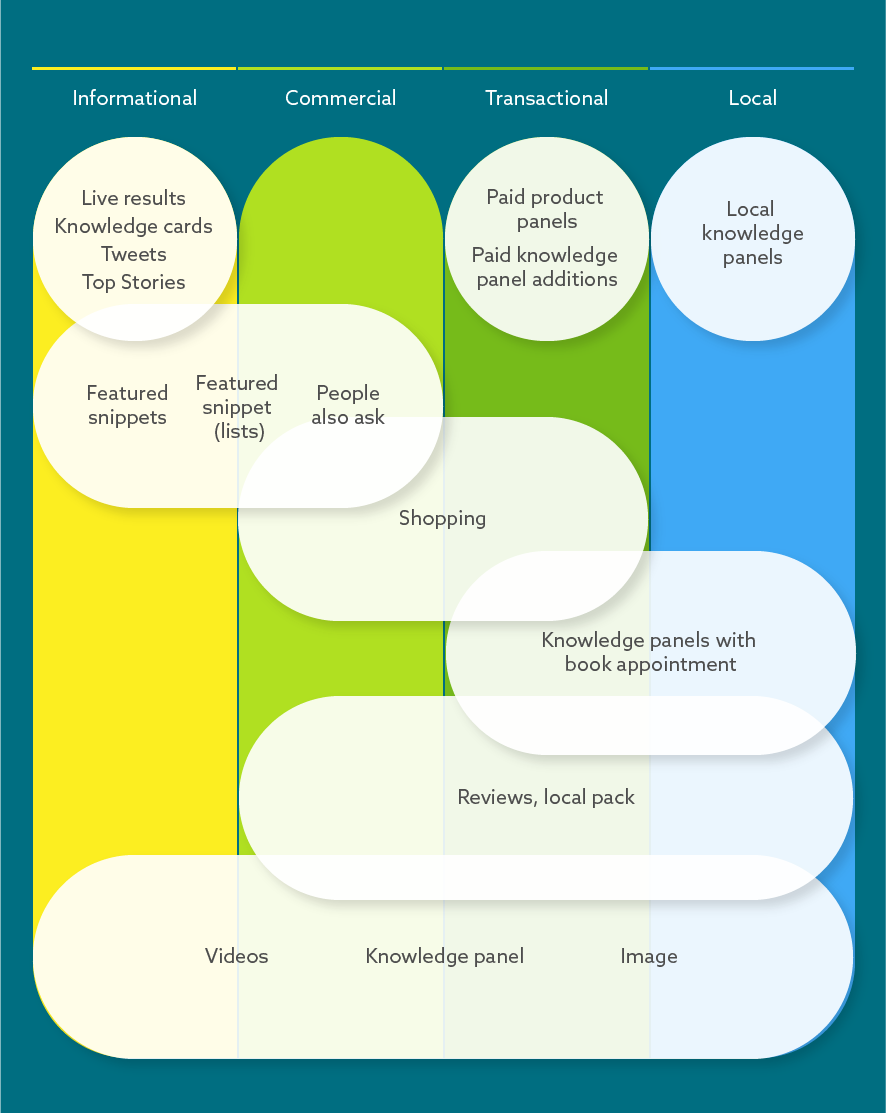
Search features by intent type
But don’t rely on this list. Time to go back to the search results and take note of what appears to be implied about intent, based on the features and their specific content.
We want to know:
-
Which feature appears.
-
Where it appears on the page, as with rankings the position of the feature implies its expected importance for the user, so this should be used to weigh up the implied intent.
-
What is in the feature - Understand the actual content of the feature. Read snippets and watch videos.
Just as you did for organic results, you need to do this for all your queries and take note of how the position and specific content of features changes for related searches. Earning featured snippets and shopping positions really can be an integral part of search success.
Bonus hybrid: Identify Intent with Answer the Public
"People also asked boxes" can help us to understand the bigger picture around a search, to understand related queries. But if you are looking for a more detailed way to understand related queries, use the free tool Answer the Public.
Identify Intent with Ads
Now let's take a look at how we can use ads to identify intent. Just the fact that ads appear in search results can imply that there is commercial or transactional intent. But, of course, some advertisers get it terribly wrong, so make sure that the ads are actually relevant to the query you are researching. You will easily be able to spot oddities with ads. Leaving those money wasters behind, take a look at the relevant ads and what they are selling.
Think about:
1. Which specific intent do these ads solve?
Use headlines and descriptions to understand the meaning behind the ads.
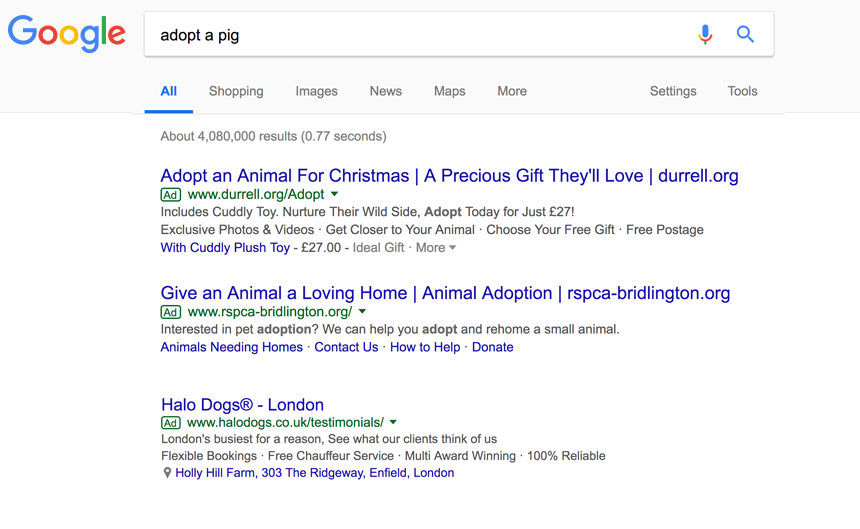
Adopt a pig - top 3 ads
We have three intents here. Adopting a pig without actually getting the pig, actually adopting an animal (but no pig?) and an ad that misses the mark and doesn’t even make sense.
2. What emotional triggers are being used?Emotional triggers in ads
It is for Christmas. That comes with emotions, tying it specifically to an occasion. They will love it. Loving home. All attempting to evoke an emotional reaction from the searcher. How do their emotions reflect on the intent of the searcher? What does it imply about their mental state when searching.
3. Do callouts or other extensions give us further insight?Callouts and sitelinks further imply intent.
We are getting a sense of urgency by asking us to adopt today. And we can see what other considerations (intents) the searcher might have with site links, like the unwavering urge to help pigs.
These examples are not the only way to use ads to identify intent. Rather than analyzing existing ads, created by your competition, you can run your own test campaigns to understand the majority intent behind your queries. If you want to find out more about how to do this, watch the upcoming webinar.
Identifying Intent by the Searcher
Now, we will look at how to understand the searcher’s intent by understanding the searchers themselves. Yes, we are actually going to talk to them.
If you thought this would be an impossible task, and way too much trouble than it is worth, you would be wrong. There is nothing better, more helpful, and more worthwhile for your business than understanding searchers, your users, and customers. They are the most important part of the equation.
Identify Search Intent via Location and Mode of Search
The location of a searcher can infer the kind of intent type behind her query. It is quite apparent that this is the case, just by the number of times we are asked for permission to use location services. Location matters, a lot.
Whether the searcher uses an actual place name within their search, a phrase like “near me” or if the location is simply implied (more on this shortly in ‘mode of search’), we expect them to have local intent. Local intent doesn’t only mean these are local queries, looking for a local result, it can also influence the meaning of a query.
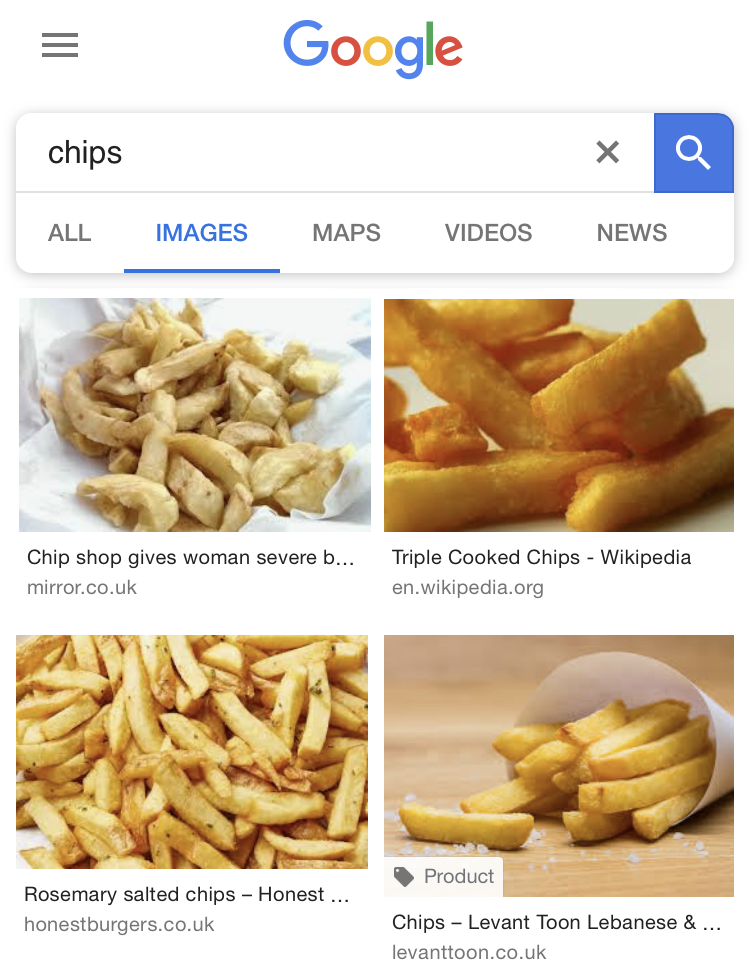
Search for chips in the UK.
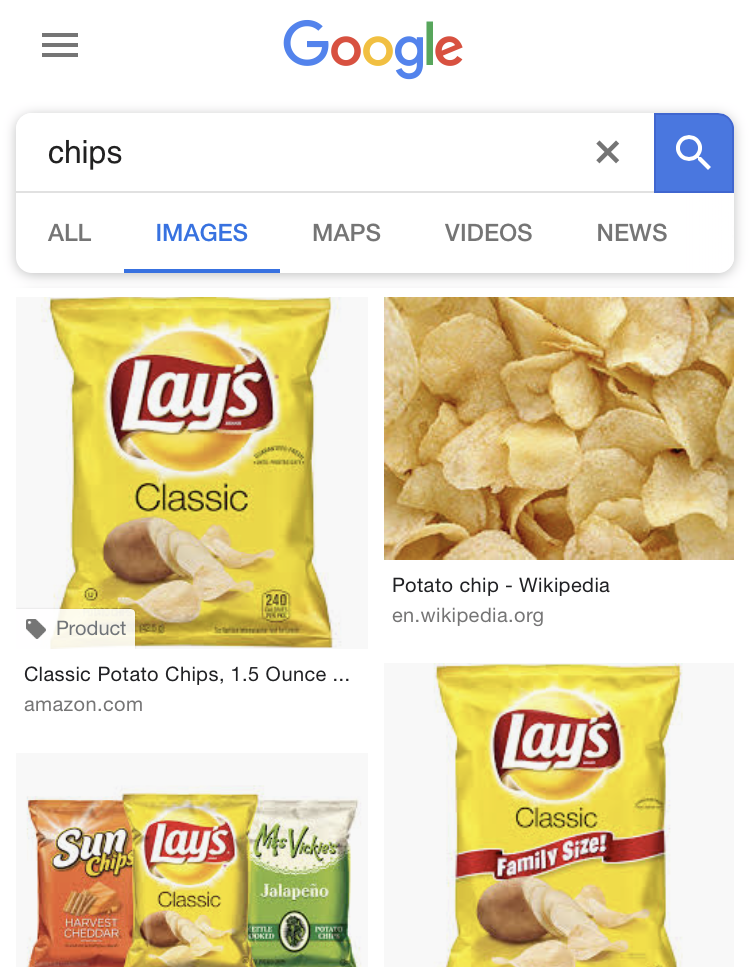
Search for chips in the US.
The physical location and mode of search are often closely linked and when looked at together can further narrow down meaning and intent. The mode of search, whether voice, mobile or desktop, allows us to glean further insight into the searcher’s intent. Voice, via a home assistant, or mobile search, imply the searcher is in a situation either less likely to look at a screen or quite literally mobile - out and about; this implies immediacy, as well as action, focused searches. Where a desktop search implies the searcher is more stationary, perhaps sitting at her desk, it means the searcher is more likely to be planning and researching, not as active, especially coupled with local intent.
How to Identify the Mode and Location of Search
There are a few ways to identify mode and location of search; some more manual than others.
Use semantics to understand the intricacies of the query:
- Is it conversational?
Example: “find me the best pizza recipe." - Is it a fully phrased question?
Example: “Where is the nearest tube?” - Does the meaning of the search query have an inherent local intent?
Example: "shoe repairs" (i.e., Local high street services)
Use intent modifiers:
Intent modifiers like “near me” don’t only imply it is a local search, but are also an indicator that the search is performed on mobile. HitWise states “Location-based searches, like those specifying “near me” are ... nearly exclusively initiated on mobile devices.”
In fact, mobile and local “near me” searches are such good friends, that users often drop the modifier and still expect a local result.
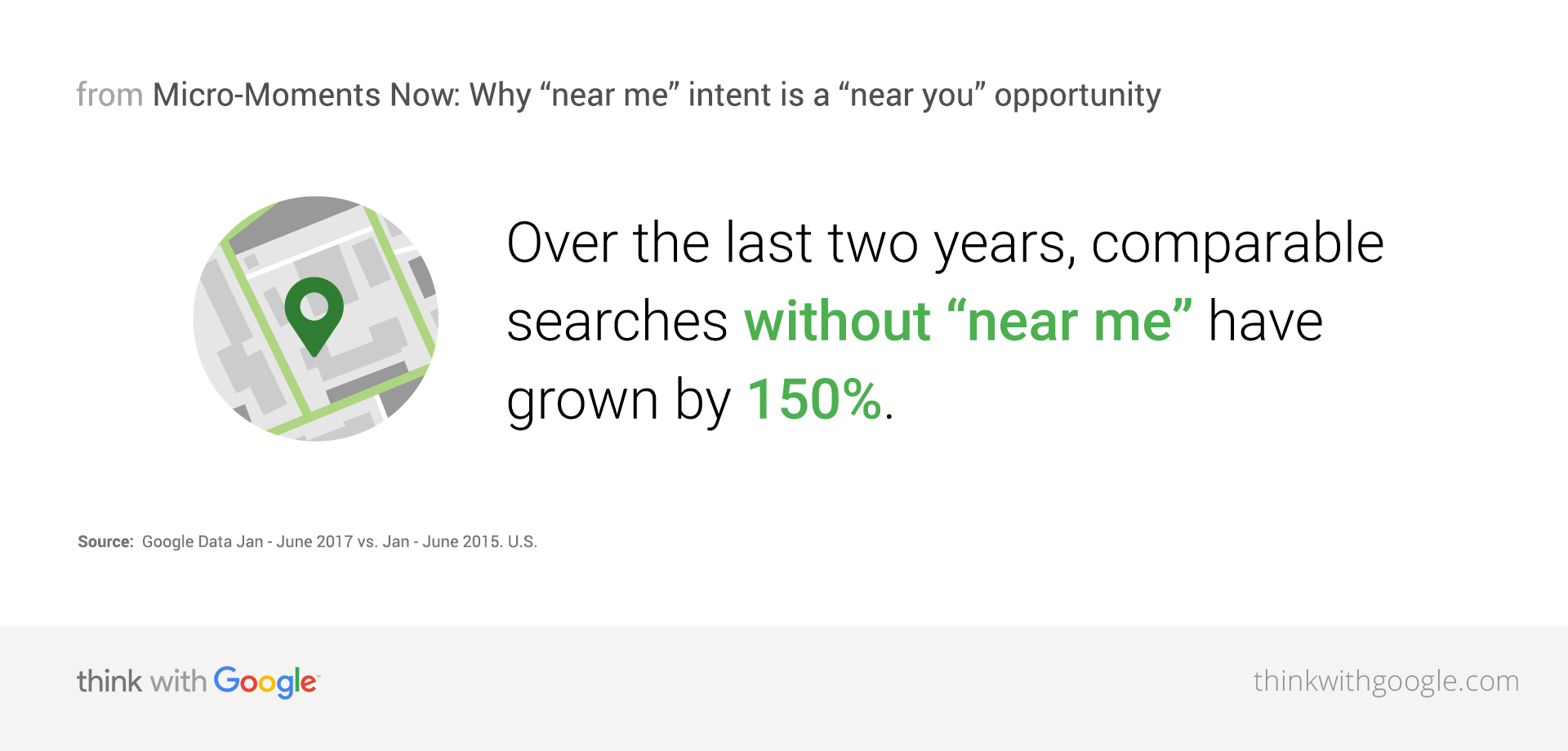
Via Think with Google.
Use Google Analytics, Search Console, and Trends:
If you have the luxury of Google Analytics data for queries you can use the search query report with a mobile segment for mobile queries and look for sentences to identify mobile voice searches.
Or you can create location segments and apply them to the report to find differences in the meaning of queries based on location.
You can also use Google Search Console with a mobile filter in your query report to do the same thing. And there has been talk about releasing mode of search details in the future.
"we are going to fix voice search" to give people more insight into when they're showing as voice query answers @methode #smx #11a
— Greg Gifford (@GregGifford) June 13, 2017
I hear folks asking about voice search data in Search Console often. Can you elaborate on what you want to see there? What's an example of such a query that would be useful? pic.twitter.com/WOqS7aH4tP
— John ☆.o(≧▽≦)o.☆ (@JohnMu) December 7, 2017
You can use Google trends filter by location to get suggestions for related topics and queries, further informing you about any added local meaning or intent.
Also, think about the time of year searches are performed in. Certain times of year will ultimately mean more commercial queries, where other times or special events might change the meaning of searches altogether. So make sure to check Google trends for seasonal demand.
Use keyword research tools:
You can use your preferred keyword research tools and filter by country, to get the searches that are performed around the topic in a given location. Looking at the spread, you can glean thee overall intent of a topic, and you can use our above methods to drill down on intent even further.
Identify Intent via User Interviews
Understanding the location and mode of search allows us to understand the searcher’s situation better, but we can go further to understand their motivations and objections. If we understand what it is that our searchers want to achieve, what kind of content they are looking for, and how they want to interact with the content, we can craft experiences directly for them.
So how do we learn about the tasks that our searchers are looking to complete?
-
Run short surveys:
Use tools like Google surveys or Survey Monkey and promote them via email and social media. -
Reach out to your existing customers via email.
Ask questions like:-
What were you looking for when you found us in search?
-
Did you buy/sign up/etc. straight away or visit the site several times?
-
If so what were you looking to answer each of the times you visited?
-
-
Just ask: call your customers.
Ask questions like the above and:-
What problem did our service/product solve for you?
-
How much time did you spend on researching different solutions?
-
What made you pick us?
-
How does our service/product make you feel?
-
All of these questions are looking to tease some honest, candid insights into the user mindset when searching for and purchasing your product or service. You can get some inspiration on these questions from CRO guides or “Jobs to be done” frameworks.
Identify Intent with Semrush
As you conduct your keyword research, you can now identify search intent and even filter for it, without leaving Semrush. In fact, Semrush can analyze keyword intent across many different workflows. You can find it in:
- Domain Overview
- Organic Research
- Keyword Overview
- Keyword Magic Tool
- Keyword Strategy Builder
- Keyword Gap
- Position Tracking
In Semrush, intent is marked by color coded letters:
- Blue I: informational intent (searchers want to know something)
- Purple N: navigational intent (searchers want to find a specific online or offline location)
- Yellow C: commercial intent (searchers researching a potential purchase)
- Green T: Transactional intent (searchers ready to buy something)
Here’s how it works:
Let’s imagine that we’re working on a content campaign, where we want to identify and target keywords related to movies with a commercial intent.
First, we’ll go to the Keyword Magic Tool, and enter our seed keyword:

Pictured above, the Keyword Magic Tool automatically displays search intent for the resulting keywords in the second column. By default, all types of search intent are included in the results. If you need to narrow your search down, expand the “Intent” filter. Then choose the search intent you want to include.

If we select “commercial” from this menu, we will only see keywords with that intent, excluding all others.

From here, you can continue to narrow down your search using the Keyword Magic Tool’s filter options, send your preferred keywords to the Keyword Strategy Builder, or even export them all to a CSV or XLSX file for further analysis.
What’s next?
You now know how to research and really understand search intent, so use that knowledge. Supplement your keyword research with intent research. Go even further and make decisions on whether and how to target a term based on searcher's intent. Create content with intent in mind, making sure future searchers will be able to complete those tasks they set out to on your site.
